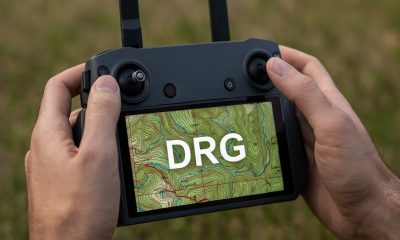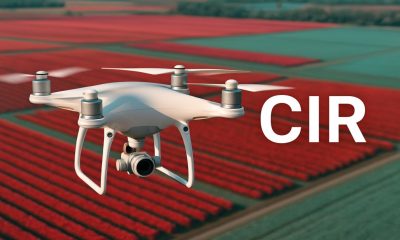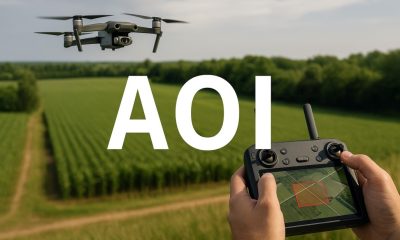- Acronym Guide
- AAM
- ABS
- AC
- ACAS
- ADS-B
- AFAC
- AGL
- AI
- AIM
- ALS
- AM
- AMA
- ANSP
- AOI
- APPI
- AUV
- AUVSI
- ARPAS-UK
- ASTM
- ATC
- BVLOS
- CAA
- CAAC
- CAB
- CASA
- CATT
- CBO
- CBR
- CBRN
- CDMA
- CDR
- CFR
- CIR
- COA
- COMINT
- CORS
- COTP
- COTR
- CPTED
- CV
- C2
- DAA
- DEM
- DFI
- DFS
- DGCA
- DHS
- DOD
- DPA
- DPEs
- DRG
- DRO
- DSM
- DSMX
- DSP
- DSSS
- DTM
- EASA
- EFT
- EO
- EOD
- EO/IR
- ELINT
- EMI
- ESC
- EVLOS
- eVTOLs
- FAA
- FCC
- FCS
- FHSS
- FICCI
- FLIR
- FOB
- FOV
- FPS
- FPV
- GBDAA
- GCP
- GCS
- GDPR
- GML
- GNSS
- GPS
- GSD
- GVC
- HDR
- HOGE
- IACRA
- ICAO
- ICS
- IMU
- INS
- IR
- ISA
- ISR
- ITU
- JARUS
- LAAMS
- LAANC
- LAATM
- LAI
- LBA
- LIDAR
- LOS
- LSALT
- MAC
- MAVLink
- MLIT
- MMS
- MSL
- MTOM
- NDAA
- NCSL
- NFZ
- NIST
- NMEA
- NOTAM
- NPA
- NPRM
- NTIA
- OBIA
- OEM
- OFDM
- OOP
- PASM
- PAV
- PCV
- PdM
- PEC
- PIC
- PID
- PIPL
- PLD
- PM
- PN
- PPK
- PPS
- PSM
- PWM
- UAM
- UAOP
- UAS
- UASTM
- UAV
- UCAVs
- UHD
- UHF
- USV
- UTM
- RAIM
- RCC
- RCS
- RFI
- ReOC
- RePL
- RMS
- ROI
- RPAS
- RPC
- RTH
- RTK
- SaR
- SAR
- SARP
- SBAS
- S.Bus
- SBIR
- SEDENA
- SfM
- SFOC
- SIGINT
- SLAM
- SMS
- SORA
- STANAG
- STTR
- sUAS
- TCAS
- TCCA
- TFR
- TIN
- TOF
- TP
- TPS
- TSA
- VHF
- VLOS
- VTOL
Drone Acronyms
What is FLIR (Forward Looking Infrared) & How Does it Work?
By
Jacob StonerTable Of Contents

Definition
FLIR stands for Forward Looking Infrared. It is a type of infrared imaging system that uses thermal imaging to detect heat emitted by objects. FLIR cameras are mounted on drones to provide real-time thermal images, which are valuable in various applications.
Relevance to the Industry
FLIR technology enhances the capabilities of drones by providing critical thermal data that is not visible to the naked eye. This data is essential for identifying heat sources, monitoring temperature changes, and detecting anomalies. FLIR-equipped drones are invaluable in public safety, industrial inspections, and environmental studies.
How Does Forward-Looking Infrared (FLIR) Work?
Forward-Looking Infrared (FLIR) technology utilizes infrared sensors to detect and visualize heat emitted by objects and environments, enabling the creation of thermal images. FLIR systems are used in various applications, including surveillance, search and rescue, industrial inspection, and military operations. Here’s a detailed explanation of how FLIR works:
1. System Components
- Infrared Camera: The core component of a FLIR system, equipped with infrared sensors that detect thermal radiation.
- Optics: Lenses and mirrors that focus infrared radiation onto the sensors.
- Detector Array: An array of infrared sensors, often made of materials such as indium antimonide (InSb), mercury cadmium telluride (HgCdTe), or vanadium oxide (VOx), which convert thermal radiation into electrical signals.
- Processing Unit: Onboard electronics that process the electrical signals from the sensors to create thermal images.
- Display: A screen or monitor that displays the thermal images to the operator.
2. Thermal Radiation Detection
- Infrared Radiation: All objects emit infrared radiation as a function of their temperature. Hotter objects emit more infrared radiation than cooler ones.
- Sensor Detection: The infrared camera’s sensors detect this thermal radiation. The sensors are sensitive to specific wavelengths of infrared light, typically in the 3-5 micron (mid-wave infrared) or 8-12 micron (long-wave infrared) ranges.
3. Image Formation
- Focus and Capture: The optics system focuses the incoming infrared radiation onto the detector array. Each sensor in the array captures the thermal radiation from a specific part of the scene.
- Signal Conversion: The infrared sensors convert the detected thermal radiation into electrical signals. The intensity of the electrical signal corresponds to the temperature of the object emitting the radiation.
- Image Processing: The processing unit converts the electrical signals into digital data, which is then used to create a thermal image. The image represents temperature variations within the scene, with different colors or shades indicating different temperatures.
4. Display and Interpretation
- Thermal Images: The processed thermal data is displayed as an image on the screen. In these images, warmer objects typically appear brighter or in warmer colors (e.g., red, yellow), while cooler objects appear darker or in cooler colors (e.g., blue, purple).
- Color Palettes: Various color palettes can be used to represent temperature differences, helping operators interpret the thermal data more easily.
5. Applications and Use Cases
- Surveillance and Security: FLIR systems are used for night vision and surveillance, detecting heat signatures of people and vehicles in low-light or obscured conditions.
- Search and Rescue: FLIR technology helps locate missing persons or survivors by detecting their body heat, even in challenging environments such as forests, mountains, or disaster sites.
- Industrial Inspection: FLIR cameras are used to inspect electrical systems, machinery, and infrastructure for overheating or faults, preventing potential failures and ensuring safety.
- Firefighting: Firefighters use FLIR to see through smoke, locate hotspots, and identify people trapped in burning buildings.
- Military and Defense: FLIR is used for target acquisition, reconnaissance, and navigation in military operations, providing visibility in complete darkness and through camouflaging materials.
- Environmental Monitoring: FLIR systems are used to monitor wildlife, detect environmental changes, and conduct thermal surveys of ecosystems.
6. Advantages and Challenges
- Advantages: FLIR provides the ability to see in total darkness, through smoke, fog, and other obscurants. It is non-invasive and can detect temperature differences with high precision.
- Challenges: The effectiveness of FLIR can be affected by environmental conditions such as rain, humidity, and extreme temperatures. Additionally, interpreting thermal images requires training and experience.
Understanding how Forward-Looking Infrared (FLIR) works highlights its capability to detect and visualize heat, offering valuable insights across a wide range of applications. By converting thermal radiation into visible images, FLIR technology enhances situational awareness, safety, and operational efficiency in various fields.
Example in Use
“FLIR-equipped drones were used to locate survivors in the aftermath of a natural disaster, detecting their heat signatures through debris and smoke.”
Frequently Asked Questions about FLIR (Forward Looking Infrared)
1. What is FLIR technology in drones?
Answer: FLIR (Forward Looking Infrared) technology in drones involves the use of thermal imaging cameras that detect infrared radiation (heat) emitted by objects. This allows drones to create thermal images that show temperature variations, which can be used to identify heat sources, monitor environments, and detect anomalies.
2. Why is FLIR important for drone operations?
Answer: FLIR is important for drone operations because it:
- Enhances Visibility: Allows drones to see in complete darkness, through smoke, and under foliage.
- Improves Safety: Detects heat sources and potential hazards, such as hotspots in firefighting or overheating equipment in industrial inspections.
- Supports Search and Rescue: Helps locate missing persons or animals by detecting their heat signatures.
- Enables Environmental Monitoring: Monitors temperature changes in ecosystems, tracks wildlife, and assesses the impact of environmental changes.
3. What are the applications of FLIR technology in drones?
Answer: Applications of FLIR technology in drones include:
- Search and Rescue: Locating survivors in disaster zones by detecting their heat signatures.
- Surveillance and Security: Monitoring areas for unauthorized activities, especially in low-light or obscured conditions.
- Firefighting: Identifying hotspots and monitoring fire spread through thermal imaging.
- Industrial Inspection: Detecting heat leaks, electrical faults, and other anomalies in buildings, power lines, and equipment.
- Environmental Monitoring: Tracking wildlife, monitoring temperature changes in habitats, and studying environmental impacts.
For examples of these acronyms visit our Industries page.
As the CEO of Flyeye.io, Jacob Stoner spearheads the company's operations with his extensive expertise in the drone industry. He is a licensed commercial drone operator in Canada, where he frequently conducts drone inspections. Jacob is a highly respected figure within his local drone community, where he indulges his passion for videography during his leisure time. Above all, Jacob's keen interest lies in the potential societal impact of drone technology advancements.
Pros
Cons
You may like


John Andrzejewski, Co-founder at Guardian RF – Innovator Series


What is OBIA (Object-Based Image Analysis)?


What is GML (Geographic Markup Language)?


What is DRG (Digital Raster Graphic) & How Does it Work?


What is CIR (Color Infrared) & How Does it Work?


What is AOI (Area of Interest) & How Does it Work?